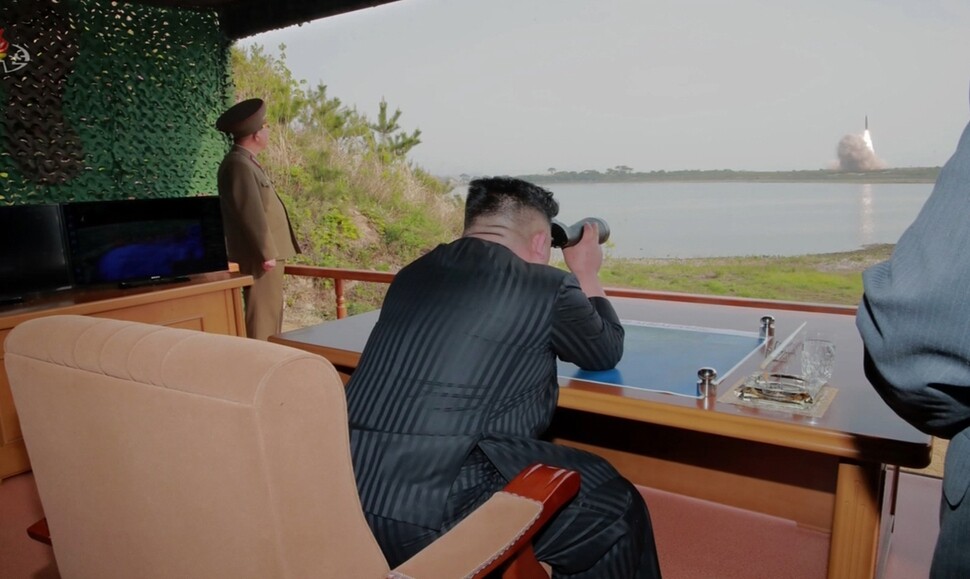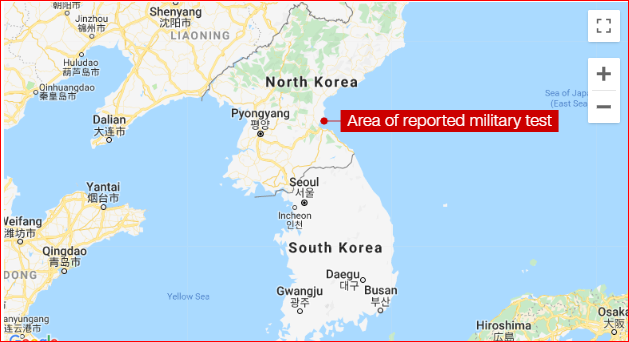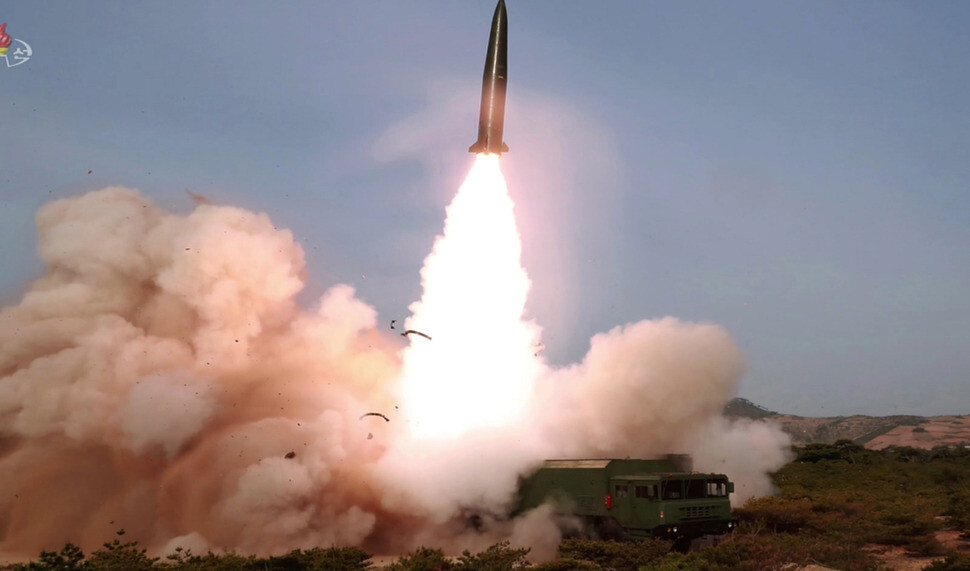hankyoreh
Links to other country sites 다른 나라 사이트 링크
[News analysis] Kim Jong-un personally supervises test launch of missiles into East Sea

North Korea carried out a “strike drill” personally supervised by the country’s leader, Kim Jong-un, in which various missile components were test fired into the East Sea. As a deadlock continues between North Korea and the US, Kim appears to be increasing low-level pressure on US President Donald Trump and South Korean President Moon Jae-in.
On May 5, the Korean Central News Agency (KCNA) reported that Kim Jong-un had “guided the strike drill of defense units in the forefront area and on the eastern front which took place in the East Sea of Korea on Saturday.”
“The purpose of the drill was to estimate and inspect the operating ability and the accuracy of striking duty performance of large-caliber long-range multiple rocket launchers and tactical guided weapons by defense units in the frontline area and on the eastern front and the combat performance of arms and equipment,” the KCNA said, as well as to keep the units “at combat readiness posture all the time.”
The KCNA reported that the drill was designed to prepare units to “launch an immediate counterattack without the slightest tolerance for any attempt by any forces to harm our independence, dignity, or survival.”
Since this was essentially North Korea’s first “show of force” since its summit with the US in Hanoi ended without an agreement, it’s fairly clear that the North was trying to put pressure on the US. With the US maintaining its pressure and sanctions on the North and continuing to ask for an all-in-one deal, the North is urging the US to alter its calculations while also hinting at the possibility of changing course.
This is in line with the remarks by North Korean First Vice Foreign Minister Choe Son-hui that the US “will see truly undesired consequences,” made in response to US Secretary of State Mike Pompeo’s warning last month that the breakdown of the nuclear talks would force the US to “change paths.”

At the same time, North Korea is assumed to be moderating its actions so as to avoid provoking a tough response from the US or the UN. According to information provided by the South Korean Joint Chiefs of Staff, the short-range missiles that North Korea launched from the area of Hodo Peninsula in Wonsan, Gangwon Province on the morning of May 4 included a new kind of tactical guided weapon as well as a large number of 240mm and 300mm rounds from multiple rocket launchers, with the missiles traveling between 70km and 240km. Short-range missiles don’t pose a direct threat to the American mainland; even if they were ballistic missiles, their short range means that they’re unlikely to trigger a response from the UN.
“[North Korea] is trying to provoke [the US] on a low level since a shock is necessary to shake things up in the standoff that has continued since the rupture [of their summit] in Hanoi,” said Koh Yu-hwan, a professor at Dongguk University.
Photographs published by the KCNA on May 5 show missile-shaped missiles shooting out flames and flying into the sky from movable launch vehicles. Considering that these missiles are vehicle-launched and look similar to the Russian Iskander missile, some observers believe that the test involved the “North Korean Iskander” that was unveiled in a military parade on Feb. 8, 2018, the 70th anniversary of the establishment of the North Korean military.
The Iskander is considered a difficult missile to intercept with a PAC-3 or THAAD due to its complex trajectory: a rapid descent followed by horizontal flight and then a vertical drop in the area over its target. The missile was reportedly launched a little after 10 am on May 4 and traveled for 240km. A launch near the Military Demarcation Line (MDL) would put the area south of central South Korea within striking range.

Strike drills indicate pressure tactic and hope for dialogue ahead of Biegun’s SK visit
Analysts also read the strike drill as sending signals of both pressure and hope for dialogue ahead of a South Korea visit on May 9–10 by State Department Special Representative for North Korea Stephen Biegun, who oversees practical matters related to North Korea talks for the US. In addition, it reads as a response to the joint South Korea-US flight training exercises that have been taking place since Apr. 22. Introduced in place of the previous annual large-scale Max Thunder air exercise, the flight training exercises have been denounced in increasingly harsh terms by North Korea recently, with the Committee for the Peaceful Reunification of the Country referring to them on Apr. 25 as an “open violation” of the military agreement reached by South and North Korea on Sept. 19, 2018. Some analysts are viewing the North’s characterization of the latest drill as being intended for combat readiness “all the time” as a form of justification, as well as a “typical” and “defensive” action in response to South Korea and the US continuing joint exercises, despite their reduced scale.
The use of a short-range missile with the South in firing range had some interpreting the drill as a message expressive Pyongyang’s disgruntlement with Seoul over the Moon Jae-in administration’s passive attitude toward inter-Korean relations. In contrast with the past, the North also released over 20 photographs of the drill in an apparent attempt to heighten its effectiveness as a bargaining tool with external powers while achieving propaganda purposes at home by underscoring the message that Pyongyang has “no issues” regarding regime security.
By Kim Ji-eun, staff reporter
Please direct comments or questions to [english@hani.co.kr]

Editorial・opinion
![[Column] Has Korea, too, crossed the Rubicon on China? [Column] Has Korea, too, crossed the Rubicon on China?](https://flexible.img.hani.co.kr/flexible/normal/500/300/imgdb/original/2024/0419/9317135153409185.jpg) [Column] Has Korea, too, crossed the Rubicon on China?
[Column] Has Korea, too, crossed the Rubicon on China?![[Correspondent’s column] In Japan’s alliance with US, echoes of its past alliances with UK [Correspondent’s column] In Japan’s alliance with US, echoes of its past alliances with UK](https://flexible.img.hani.co.kr/flexible/normal/500/300/imgdb/original/2024/0419/2317135166563519.jpg) [Correspondent’s column] In Japan’s alliance with US, echoes of its past alliances with UK
[Correspondent’s column] In Japan’s alliance with US, echoes of its past alliances with UK- [Editorial] Does Yoon think the Korean public is wrong?
- [Editorial] As it bolsters its alliance with US, Japan must be accountable for past
- [Guest essay] Amending the Constitution is Yoon’s key to leaving office in public’s good graces
- [Editorial] 10 years on, lessons of Sewol tragedy must never be forgotten
- [Column] A death blow to Korea’s prosecutor politics
- [Correspondent’s column] The US and the end of Japanese pacifism
- [Guest essay] How Korea turned its trainee doctors into monsters
- [Guest essay] As someone who helped forge Seoul-Moscow ties, their status today troubles me
Most viewed articles
- 1[Column] The clock is ticking for Korea’s first lady
- 2Samsung barricades office as unionized workers strike for better conditions
- 3[Editorial] When the choice is kids or career, Korea will never overcome birth rate woes
- 4[News analysis] After elections, prosecutorial reform will likely make legislative agenda
- 5S. Korea, Japan reaffirm commitment to strengthening trilateral ties with US
- 6All eyes on Xiaomi after it pulls off EV that Apple couldn’t
- 7After 2 months of delayed, denied medical care, Koreans worry worst may be yet to come
- 8US overtakes China as Korea’s top export market, prompting trade sanction jitters
- 9[Column] Has Korea, too, crossed the Rubicon on China?
- 10Hong Se-hwa, voice for tolerance whose memoir of exile touched a chord, dies at 76